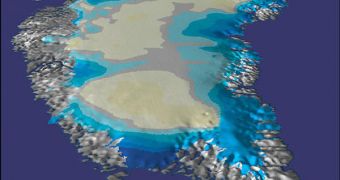According to a new scientific study, conducted by experts at the US National Center for Atmospheric Research (NCAR), the coasts of the United States and Canada may actually be more in danger than previous models have predicted. The largest threat comes from the melting ice sheet of Greenland, which, if separated from the land, could considerably drive sea levels up in the North Atlantic. Among the most-at-risk cities, the experts included New York, Boston, and Halifax, as well as other metropolitan areas on the coastlines.
“If the Greenland melt continues to accelerate, we could see significant impacts this century on the northeast US coast from the resulting sea level rise. Major northeastern cities are directly in the path of the greatest rise,” the lead author of the research, NCAR scientist Aixue Hu, warns. A paper detailing the prediction appears in the Friday issue of the respected scientific journal Geophysical Research Letters.
The investigation has also revealed that, if moderate to high percentages of Greenland's ices melt, by 2100 the Northern Atlantic could experience a shift in current and water flow patterns, which could directly result in floods and more extreme weather events, such as stronger hurricanes and tornadoes. Sea levels could rise by approximately 12 to 20 inches (about 30 to 50 centimeters), which means that a large part of the current levy system could be rendered absolutely useless in protecting the population.
Paper co-author Gerald Meehl, who is also a researcher at NCAR, warns that the rise in water level will not affect all the coastlines of the world in the same way. “The oceans will not rise uniformly as the world warms. Ocean dynamics will push water in certain directions, so some locations will experience sea level rise that is larger than the global average,” he tells.
A recent study of the Antarctic ice sheet demonstrated that, if the Southern ice spreads fell apart, they would not necessarily raise the levels of the Antarctic Ocean, but would rather move North, past the Equator, and into the North Atlantic, directly affecting the Spanish, Portuguese, English and Norwegian coasts, as well as those of the US and Canada. It goes without saying that, if both Greenland and Antarctica go at the same time, the water level modifications will be larger in the North Atlantic than the global mean.

 14 DAY TRIAL //
14 DAY TRIAL //